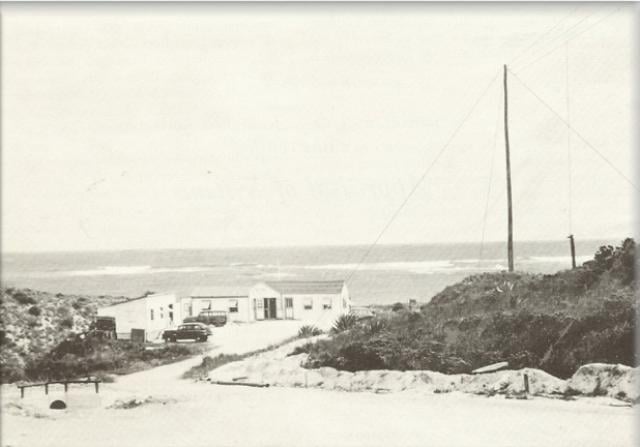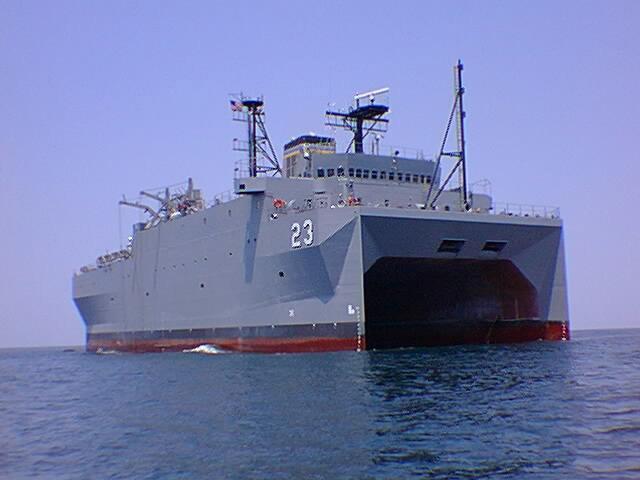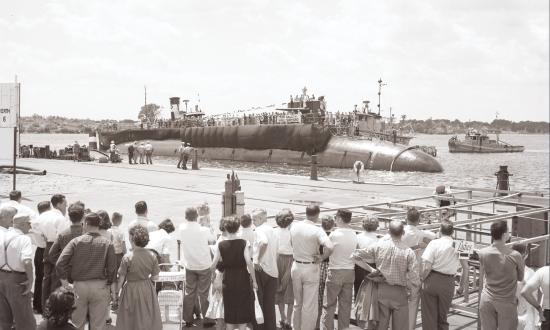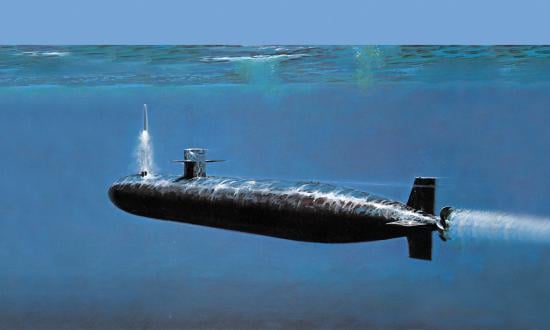Just over 66 years ago, one of the Navy’s most secretive communities began. Its members went by the code word SOSUS, which means “Sound Surveillance System.” A new front line in the Cold War, they had one mission: FIND SUBMARINES.
Lack of knowledge and information concerning oceanographic and acoustic conditions off the continental coasts hampered the U.S. Navy’s efforts against the submarine threat during World War II. It was apparent the German Navy had better information and a better understanding of how to use the Atlantic Ocean. Consequently, since the war, the U.S. Navy has maintained a continuous program of oceanographic surveys designed to provide more detailed information on currents, temperature, salinity, and other factors that comprise the oceanic environment and affect the transmission of sound in saltwater. The U.S. Navy was determined never to again lag behind others in its knowledge of this vital battlespace.
In early 1950, on the recommendation of the Committee on Undersea Warfare to the Assistant Chief of Naval Operations, Project Jezebel was born—a long-range program dedicated to the detection, classification, and localization of enemy submarines.
A meeting between admirals, Bell Telephone Laboratories, and a Massachusetts Institute of Technology representative resulted in Project Hartwell, a research group authorized to study the long-range aspects of antisubmarine warfare. Experiments conducted during the spring of 1950 revealed that submarines radiate strong sounds in the low-frequency spectrum. Project Hartwell discovered significant details of low-frequency sound, which would aid in developing a method for detection of submarines at great distances.
The Navy’s decision to pursue and further fund the research of low-frequency radiated noise resulted in the creation of Project Jezebel. In December 1950, the Office of Naval Research awarded a contract to the Western Electric Company (WECO) to continue research in detecting and identifying the low-frequency sounds radiated by submarines and proceed with development work aimed at the manufacture and installation of equipment for detecting and classifying submarines at long ranges.
Under the supervision of Navy Lieutenant Joe Kelly, Project Jezebel received authorization for six experimental stations. In 1951, a six-element array was installed at Eleuthera Island in the Bahamas. Lieutenant Kelly later became to be known as “the Father of SOSUS.” The experimental stations would be referred to as Caesar stations. The six original Caesar stations had grown to nine, tasked with providing surveillance off the U.S. East Coast.
To operate the equipment in these stations, the Navy developed Sound Search Course 572, taught out of Key West, Florida. The course was classified; even the service records of the sailors who originally manned these stations were classified. When the first sonar operators arrived at their stations, they had no experience, no reference material, no publication library, no experts to call on, and no previous low-frequency (LOFAR) grams to compare. One of the original analysts said, “We had nothing, we knew nothing, we did not know what made the lines, spacing, etc., how they got to the paper, etc. We were taught harmonics in reference to music, we had to think about every line, what could be making it? And develop a theory about its origin.”
In 1954 Navy, WECO and the Seabees were authorized to develop and build ten additional Caesar stations, three Atlantic, seven Pacific. On 18 September 1954 Naval Facility (NAVFAC) Ramey Air Force Base Puerto Rico was the first commissioned; this became known as the birth of SOSUS. The worldwide expansion of U.S. Navy SOSUS coverage had begun.
Caesar stations were windowless buildings with rows of recorders displaying the sound received by hydrophones located hundreds to thousands of miles away on the ocean floor. Each recorder displayed a sound from a separate beam, correlating to a direction. Analysts would walk up and down the rows of machines analyzing the signals on each recorder; this became known as “walking the beams.” Raw data received by the hydrophones fed through processors, converted to varying electrical current and displayed on recorders referred to as gram writers. Each recorder was equipped with large spools of paper that would scroll bottom to top on a metal plate as styli scrolled in unison horizontally across chemically coated paper, burning the paper at varying intensities depending on how loud the detected noise was, thus displaying the acoustics received by the hydrophones. Even though analysts no longer physically perform these functions, the term “walking the beams” is still used on watch floors today.
The 1960s witnessed the development and growth of undersea surveillance. New NAVFACs opened as the system had success after success. To manage the NAVFACs located throughout the world required two separate commanders—Commander, Oceanographic Atlantic, and Commander, Oceanographic Pacific. Some of the decade’s successes include: tracking the ballistic-missile submarine USS George Washington (SSBN-598) from the waters off the continental United States to the United Kingdom; tracking multiple Soviet diesel and nuclear submarines; and the first positive correlation of a SOSUS contact and fixed-wing patrol contact, made off a Soviet Foxtrot-class submarine during the Cuban Missile Crisis.
SOSUS was designed as an early-warning surveillance system; however, a tragic naval accident highlighted yet another application to which SOSUS became useful. In 1963, SOSUS analysts detected the sinking of the nuclear-powered attack submarine USS Thresher (SSN-593). Analysis of the LOFARgrams pinpointed the exact location of the incident and the wreckage. Later in the decade, SOSUS played similar roles after two more equally horrific, incidents occurred with the Skipjack-class submarine USS Scorpion (SSN-589) and Soviet K-129. Both suffered catastrophic casualties and sank.
With the 1970s came technological upgrades in both shore processing and underwater systems. Major advancements in cable technology stimulated the consolidation of NAVFACs into “super” NAVFACs. In addition, U.S. and Canadian forces combined operations at NAVFAC Argentia, Newfoundland. While the smaller, older facilities decommissioned, the first super NAVFAC commissioned in Brawdy, Wales. Super NAVFACs ultimately became Naval Ocean Processing Facilities (NOPFs). These facilities were manned by sonar operators and electronic technicians until ocean systems technician analysts and ocean systems technician maintainers replaced both rates.
In 1972, the concept of towing a long line of hydrophones from a surface ship was proving to be a highly effective method of detecting submarines at long distances. The Navy recognized its value both as a mobile augmentation to the SOSUS fixed arrays and as a means of extending sonar coverage of combatant ships. Ocean surveillance ships (T-AGOS) were specifically designed to tow long-line hydrophone arrays at slow speeds, in areas where fixed arrays lacked acoustic coverage.
By the 1980s SOSUS had grown to a community of thousands of sailors and multiple fixed and mobile systems; SOSUS and the surveillance towed array sensor system (SURTASS) consolidated under a new name, the Integrated Undersea Surveillance System (IUSS). The system saw widespread consolidation of shore assets, a new test array named the “Fixed Distribution System,” arrival of the first operational SURTASS ships, and delivery of the cable repair ship USNS Zeus (T-ARC-7).
The first SURTASS ship, the USNS Stalwart (T-AGOS-1), was commissioned in 1984, followed by the Contender (T-AGOS-2) and Vindicator (T-AGOS-3). Over the next seven years, 18 SURTASS ships were commissioned, necessitating the need for a ship and array repair facility; thus, IUSS Operations Support Center was stood up in Little Creek, Virginia.
As technology rapidly advanced, facilities were consolidated, while coverage remained in place. The ability to transmit acoustic data to one centralized facility reduced manning requirements and led to smaller and older facilities closing. Naval Ocean Processing Facility (NOPF) Dam Neck and NOPF Whidbey Island both commissioned in the ’80s; of the 31 NAVFACs/NOPFs, they are the only two still in operation.
In 1991, as the Cold War came to a close with the dissolution of the Soviet Union, the IUSS mission was declassified after 41 years of secrecy. The SURTASS fleet took a step forward with the commissioning of the USNS Victorious (T-AGOS-19), the first Small Waterplane Area Twin-Hull (SWATH) SURTASS vessel, in 1992. The SWATH hull gave the vessel a high degree of stability in high seas while conducting operations at slow speeds. Civilian mariners operate SURTASS, however; they do not conduct acoustic analysis. Acoustics are analyzed on board or transmitted to a shore facility for analysis.
In 1994, the Commanders Undersea Surveillance, Atlantic and Pacific, decommissioned and consolidated into one central command—Commander, Undersea Surveillance, located in Norfolk, Virginia, later relocating to Dam Neck, Virginia.
With the realization that submarines were becoming quieter and detection ranges decreasing, the Navy looked to active sonar. They approved research of new system called low-frequency active (LFA). Passive sonar relies on the source being loud enough to be detected by a receiver. Active sonar transmits its own signal; the transmission travels to an object’s surface, bounces off, and returns to the receiver. LFA uses a much lower frequency than standard active sonars, so it travels greater distances. LFA testing would continue over the next 12 years. In 2003, the ocean surveillance ship MV Cory Chouest would become the first LFA operational asset.
The OT rating was disestablished in 1997 and sonar technician surface rating filled the majority of the IUSS billets and duties. Submarine sonar technicians and aviation warfare systems operators filled in the remaining billets. With the rating conversion, the throughput for IUSS formal training dwindled, culminating the disestablishment of the formal training pipeline at the Submarine Learning Center in 2006.
With the emerging Chinese threat in the Pacific and its large search area, all SURTASS vessels were transferred to the Pacific fleet. USNS Impeccable (T-AGOS-23) and Able (T-AGOS-20) transferred from the Atlantic fleet to Pacific fleet in 2003. By 2015, three of four Victorious-class vessels were outfitted with a compact version of LFA (CLFA,) and the Impeccable is equipped with LFA. Each SURTASS vessel is outfitted with the TL-29A twin-line array, a variation on the submarine TB-29 array.
SURTASS vessels are unique platforms as their sailors (MILDET) only have access to the sonar equipment while on board in a forward-deployed naval force capacity. The MILDETs live and train out of NOPF Whidbey Island, Washington, deploy to meet the ship, and immediately deploy for three to five months of underway operations. With no place to train when not forward-deployed, the Pacific Submarine Force invested in the first high-fidelity trainer installed at Whidbey Island in 2012. Over the years, updates have included two more trainers (three in total), control monitoring stations, and improved simulation capability.
While SOSUS arrays’ primary function is detecting submarines, they also have environmental applications, such as tracking whales and their migration patterns, and seismic events. Alternate or dual-use partnerships exist with a number of agencies and institutions. The National Oceanic and Atmospheric Administration (NOAA) Vents program at its Pacific Marine Environmental Laboratory was granted access to sanitized SOSUS data at Whidbey Island in October 1990. This study combined raw analog data from specific hydrophones with NOAA systems for continuous monitoring of the northeast Pacific Ocean for low-level seismic activity and detection of volcanic activity along the northeast Pacific spreading centers.
A push to reinvigorate IUSS-specific training occurred in 2014. Submarine Learning Center re-established IUSS pipeline training with submarine learning facility detachments at schoolhouses co-located with NOPF Whidbey Island and NOPF Dam Neck. With 11 formal courses being taught and three new courses in development, IUSS training is healthy and will continue to meet the mission.
Development of future capabilities are moving forward swiftly with a new SURTASS vessel (TAGOS X) under development. Also, a deployable version of the SURTASS system, called Expeditionary SURTASS (SURTASS E) has deployed twice. SURTASS E provides a passive surveillance system in containerized boxes. Modular in design, the system can be installed on the back of nearly any flat-decked ship providing tremendous flexibility for when and where to operate. Additionally, numerous small systems, easily deployed from any manner of ships are under development and comprise the Deployable Family of Systems (DSS). The Maritime Surveillance Systems Program Office is developing DSS that are unmanned deployable systems for rapid installation worldwide. These systems provide asymmetrical response to proliferation of quiet submarines. DSS includes deep-water passive, deep-water active, and mobile passive and active systems. Some current projects include gliders, the Transformational Reliable Acoustic Path System, the Deep-Water Active Distributed System, and sensor-hosted autonomous remote crafts.
Lastly, efforts are underway to upgrade and replace the existing underwater cables to bring them up to the standards needed to detect quiet, modern submarines.
The new millennium arrived and ushered in a new era of challenges for IUSS. Demonstrating the adaptability and flexibility that has characterized the community over the last 60-plus years, IUSS continues to meet the nation’s maritime surveillance requirements.











